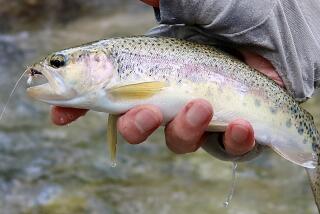A River Tamed
- Share via
The Santa Ana River, its 2,450-square-mile drainage basin including much of Orange County, poses the largest flood threat west of the Mississippi River. The Santa Ana Mainstem Project, begun in 1986, is designed to decrease chances that an immense flood would inundate large portions of the county. The overall project is estimated to cost $1.3 billion.
Seven Oaks Dam
Located near the river headwaters in the San Bernardino Mountains. At 550 feet high, the earthen dam will be as tall as the Washington Monument.
* 43 million cubic yards of clay and rock used in construction.
* Designed to withstand greater than an magnitude 8 earthquake (the 1994 Northridge quake was measured at 6.6).
Prado Dam
Increasing holding capacity at the Riverside-Orange counties line from 212,000 to 362,000 acre-feet will minimize stress on the Santa Ana River bed.
* Raise elevation from 566 feet to 594.4 feet
* Increase reservoir area from 6,695 acres to 10,256 acres
* Increase area absorbing flood waters by 2,000 acres
Flood Dangers
Without Santa Ana River flood control, it is estimated severe storms could:
* Flood more than 110,000 acres to an average depth of three feet
* Threaten the lives of 3.35 million people in three counties
* Damage 255,000 structures
Concrete Flood Control
The Santa Ana River has been rechanneled away from freeways and houses, removing curves and waterfalls that naturally slow water flow. Here’s how engineers substituted some man-made designs for natural features to manage the threat of flood:
A. Pier Noses: Concrete footings on bridges catch trees, debris in rushing water, prevent bridge damage.
B. Drop Structures: Concrete ledges constructed every 3,000 feet slow flow of water, help prevent riverbank erosion.
C. Artificial Rapids: Series of concrete teeth work like boulders to slow water flow, prevent erosion of river bottom and banks.
Riverbed Designs
These ae the four different types of riverbed designs used. Numbers correspond to reaches of river below, right:
Grouted rip rap
Use: Prevents water from eroding riverbank.
Construction: Riverbed deepened; rocks piled along banks are bonded with concrete.
Advantage: Uses smaller rock; costs less than rip rap.
*
Rip rap
Most common treatment.
Use: Slows, stabilizes fast moving water.
Construction: Riverbed deepened; rocks piled along banks.
Advantage: Less costly than concrete lining; maintains earthen river bottom.
*
Concrete-lined trapezoid
Use: Moves fast water in narrow part of river without erosion.
Construction: Walls and riverbed are flattened, lined with steel bars, covered with concrete.
Advantage: Wider top provides additional flow.
*
Rectangle
Use: Increases channel carrying capacity without increasing existing width.
Construction: Banks squared with river bottom, covered with concrete; bottom may be earthen or concrete.
Advantage: High (22-28 feet) concrete walls handle flow without erosion.
Reach by Reach
Riverbed sections are called reaches. All portions of the $1.3-billion construction are complete and trees and bushes are being added for aesthetic value. Where to find the different types of riverbed.
Beginning to End
The Santa Ana River winds 75 miles through three counties before reaching the Pacific Ocean. Named by the Portola expedition in 1769, it once emptied into Lower Newport Bay but was rechanneled in 1921. Perhaps the most devastating breach of its banks in Orange County occurred in 1938, when 2,000 people were left homeless and 19 killed.
Quote
“With the completion of the Santa Ana River Project, we will be relieved from the threat of the 100-year flood and the $18 billion in damages a storm that size could dump on the county.”--Rep. Dana Rohrabacher, 45th Congressional District.
Shifting Estimates: Estimates financial responsibility has shifted toward conty and state agencies since 1990. Amounts in millions:
Local
‘90: $473
‘95: $555
*
Federal
‘90: $973
‘95: $778
Cost Division: The federal government and Orange County provide nearly all the funding for the project.
Federal government: 59%
Orange County: 38%
Riverside County: 2%
San Bernardino County: 1%
Expensive Aspects: Cost division for individual aspects:
Prado Dam: 35%
Santa Ana River: 29%
Seven Oaks Dam: 27%
Other features: 9%
Flow Rate: At the heart of flood control is the ability to move water away from possible flood zones as quickly as possible. Water flow rate at the mouth of the river has been increased by two-thirds, to 47,000 cubic feet per second--roughly the amount of water it would take to fill a building 30 feet square by five stories tall.
Cubic feet per second:
Before project: 28,000
Current: 47,000
River Life: County officials say the project is a mixture of managing flood threats with protecting natural habitat. Some notable species that live in or around the river:
Golden eagle
Great blue heron
Red-tailed hawk
Turkey vulture
Badger
Mule deer
Sources: Orange County Environmental Management Agency, U.S. Army Corps of Engineers, Times reports; Researched by APRIL JACKSON / Los Angeles Times
More to Read
Sign up for Essential California
The most important California stories and recommendations in your inbox every morning.
You may occasionally receive promotional content from the Los Angeles Times.










